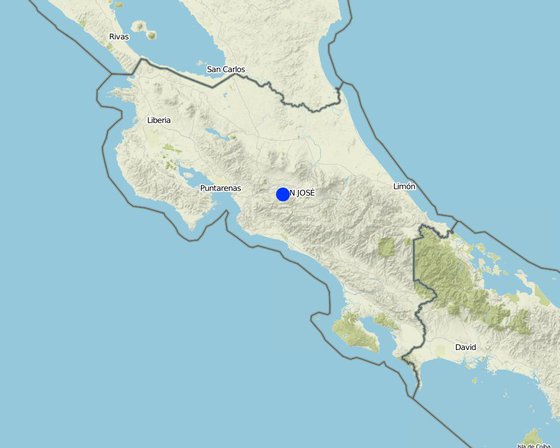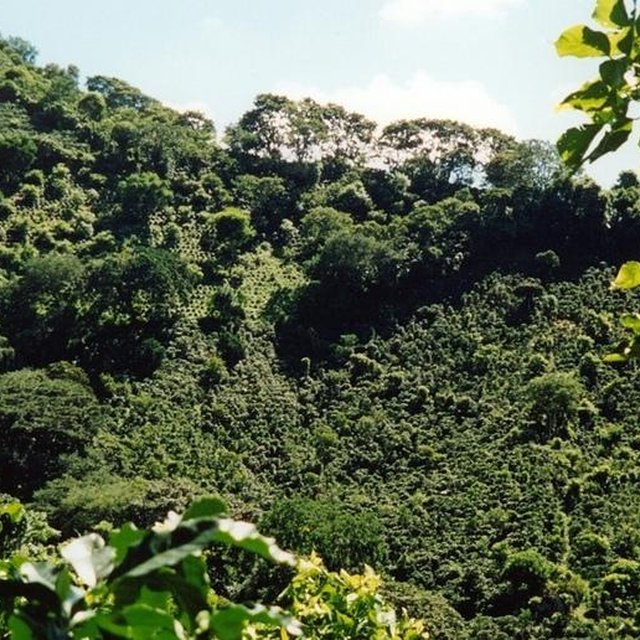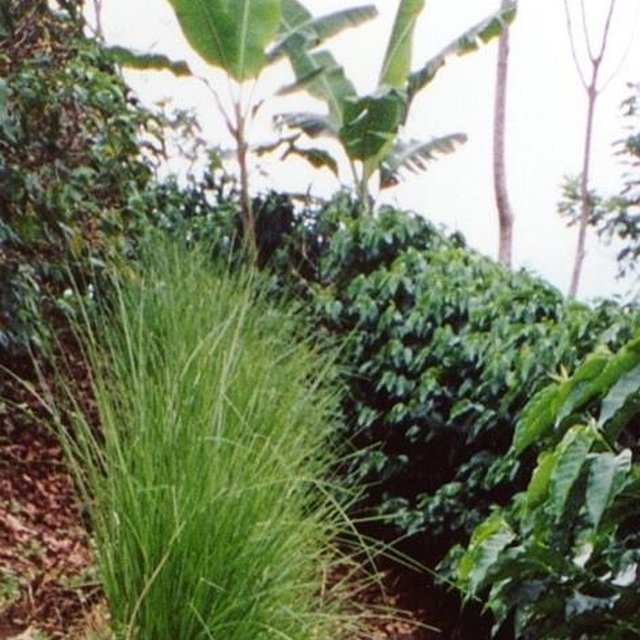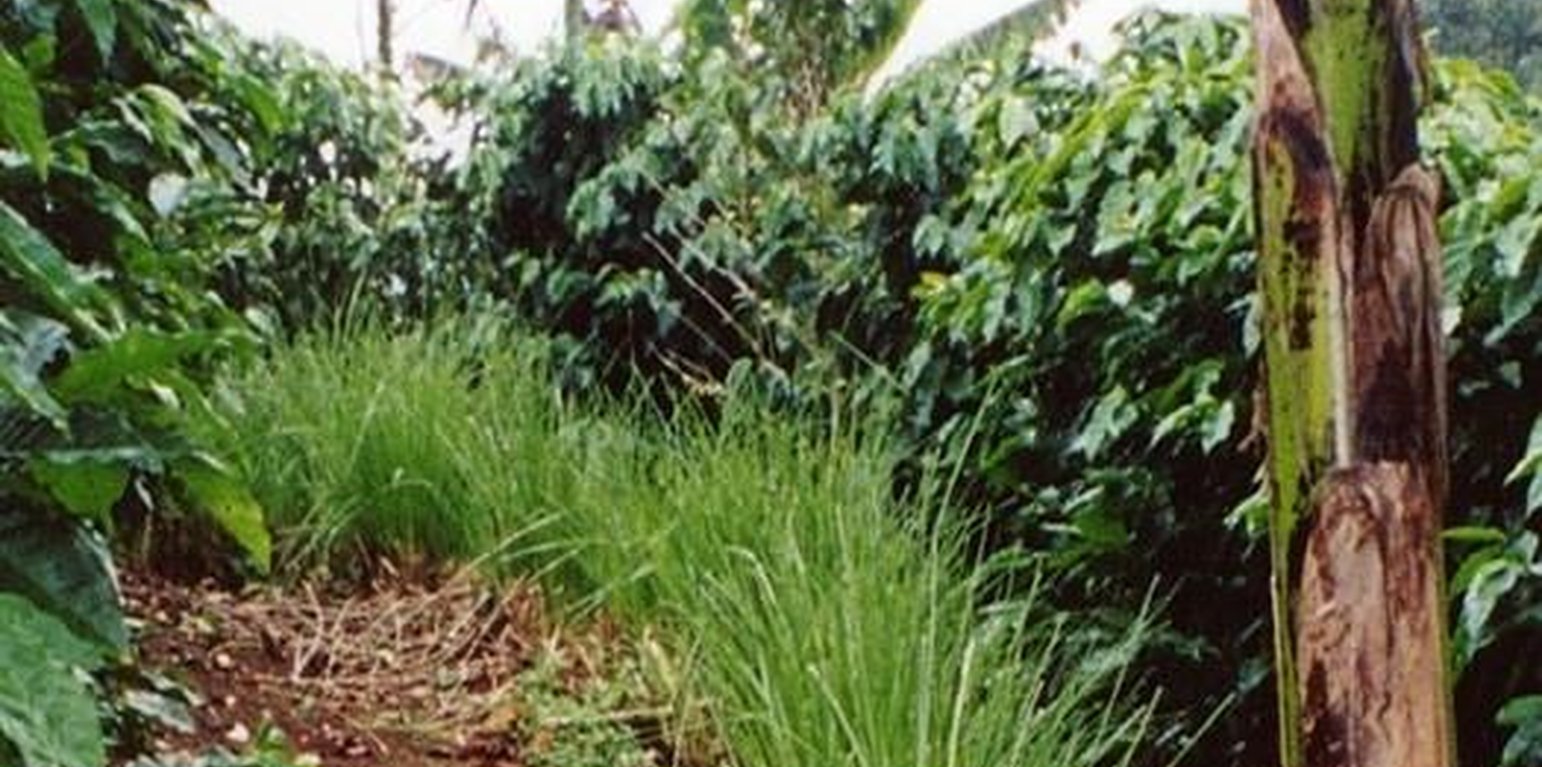Shade-grown coffee
(ប្រទេសកូស្តារីកា)
Café arbolado (spanish)
ការពណ៌នា
An agroforestry system which combines coffee with shade trees - including fruit, timber and leguminous species - in a systematic fashion.
Shade-grown coffee is a traditional and complex agroforestry system where coffee is associated with various other species in different storeys (or ‘levels’). This provides ecologically and economically sustainable use of natural resources. Café arbolado, the example promoted by PRODAF (Programme for Agroforestry Development, see related approach: ‘Agroforestry Extension’) since 1987 is one technical option for shade-grown coffee.
While based on a traditional system the shade-grown coffee technology has a specific layout, and a reduced number of intercropped species. It comprises: (1) Coffee (Coffea arabica) planted on the contour at approximately 5,000 plants per hectare; (2) Associated trees: fruits, most commonly oranges (120 trees/ha), cedar (Cedrela odorata) or caoba (Swietenia macrophylla) for timber (60 trees/ha) and also two legumes, poró (Erythrina poeppigiana) and chalum (Inga sp.) which act as shade trees and at the same time improve the soil by fixing nitrogen (60 trees/ha). Farmers often include bananas in the system. In some cases, orange trees have partly been substituted by avocado (Persea americana), soursop (Anona muricata), and/or jocotes (Spondias purpurea). The latter two command good market prices and do not compete with labour needed for harvesting and other activities; (3) Supportive soil conservation measures on steep slopes to avoid soil erosion, predominantly strips of lemon grass (Cymbopogon citratus) on the contour, retention ditches and soil cover improvement; (4) Fertilizers: both organic and inorganic combined.
Full establishment of a shaded coffee plot can be achieved in two years - after replanting trees which fail to establish. Coffee yields a harvest after two years, but timber from associated trees can be expected after only 25 years. The trees grown in association allow more efficient cycling of nutrients (because of deep rooting and nitrogen fixation) and provide a favourable microclimate for coffee. This production system is well adapted to the local biophysical and socio-economic conditions, characterised by steep erosion-prone mountain slopes, humid climate and small to medium scale agriculture. Based on café arbolado a new, and further developed system of ‘sustainable coffee’ has evolved. This involves certification of the overall process and is attractive to the growing number of environmentally conscious consumers.
ទីតាំង

ទីតាំង: Acosta-Puriscal, San José/Río Parrita, ប្រទេសកូស្តារីកា
ចំនួនទីកន្លែងបច្ចេកទេស ដែលវិភាគ:
ចំណុចយោងភូមិសាស្ត្រនៃទីតាំងជ្រើសរើស
ការសាយភាយនៃបច្ចេកទេស: ត្រូវបានផ្សព្វផ្សាយត្រឹមតំបន់មួយ (400.0 km²)
តើស្ថិតក្នុងតំបន់ការពារអចិន្ត្រៃយ៍?:
កាលបរិច្ឆេទនៃការអនុវត្ត:
ប្រភេទនៃការណែនាំឱ្យអនុវត្តន៍៖
-
តាមរយៈការបង្កើតថ្មីរបស់អ្នកប្រើប្រាស់ដី
-
ជាផ្នែកនៃប្រព័ន្ធប្រពៃណី (> 50 ឆ្នាំ)
-
ពេលកំពុងពិសោធន៍
-
តាមរយៈគម្រោង / អន្តរាគមន៍ពីខាងក្រៅ

An overview showing variations of the technology with different levels of tree cover and different stages of coffee growth: newly established (upper left) and well-developed coffee (lower right). (Esther Neuenschwander)

-
គោលបំណងចម្បងៗ
-
ធ្វើឱ្យប្រសើរឡើងនូវផលិតកម្ម
-
កាត់បន្ថយ, បង្ការ, ស្តារឡើងវិញនូវការធ្លាក់ចុះគុណភាពដី
-
អភិរក្សប្រព័ន្ធអេកូឡូស៊ី
-
ការពារតំបន់ទីជម្រាល/តំបន់ខ្សែទឹកខាងក្រោមបញ្ចូលជាមួយបច្ចេកទេសផ្សេងទៀត
-
អភិរក្ស/ធ្វើឱ្យប្រសើរឡើងជីវចម្រុះ
-
កាត់បន្ថយហានិភ័យនៃគ្រោះមហន្តរាយ
-
បន្ស៊ាំទៅនឹងការប្រែប្រួលអាកាសធាតុ/គ្រោះមហន្តរាយ និងផលប៉ះពាល់របស់វា
-
កាត់បន្ថយការប្រែប្រួលអាកាសធាតុ និងផលប៉ះពាល់របស់វា
-
បង្កើតផលប្រយោជន៍សេដ្ឋកិច្ច
-
បង្កើតផលប្រយោជន៍សង្គម
ការប្រើប្រាស់ដី
ដីប្រើប្រាស់ចម្រុះនៅលើដីតែមួយ បាទ/ចា៎ - កសិរុក្ខកម្ម
-
ដីដាំដំណាំ
- ដំណាំប្រចាំឆ្នាំ: ដំណាំចំណីសត្វ - ស្មៅ, chalum, poró, cedar, caoba, soursop
- ដំណាំរយៈពេលវែង (មិនមែនឈើ): ចេក/plantain/abaca
- ប្រភេទដើមឈើធំៗ និងដើមឈើតូចៗ: ស្វាយចន្ទី, ផ្លែប៊ឺ, កាហ្វេ នៅពេលធំមានម្លប់, ពពួកក្រូច citrus
តើជាការអនុវត្តន៍ដំណាំចន្លោះ? បាទ/ចា៎
-
ដីព្រៃ/ដីដាំដើមឈើTree types: Swietenia macrophylla
ផលិតផល និងសេវាកម្ម: ឈើហ៊ុប
ការផ្គត់ផ្គង់ទឹក
-
ទឹកភ្លៀង
-
ទឹកភ្លៀង និងប្រព័ន្ធស្រោចស្រព
-
ប្រព័ន្ធស្រោចស្រពទាំងស្រុង
គោលបំណងទាក់ទងនឹងការធ្លាក់ចុះគុណភាពដី
-
ការការពារការធ្លាក់ចុះគុណភាពដី
-
ការកាត់បន្ថយការធ្លាក់ចុះគុណភាពដី
-
ការជួសជុល/ ស្តារឡើងវិញនៃឱនភាពដីធ្ងន់ធ្ងរ
-
ការបន្ស៊ាំទៅនឹងការធ្លាក់ចុះគុណភាពដី
-
ដែលមិនអាចអនុវត្តបាន
ប្រភេទនៃការធ្លាក់ចុះគុណភាពដីដែលបានដោះស្រាយ
-
ការហូរច្រោះដីដោយសារទឹក - Wt: ការបាត់ដីស្រទាប់លើដោយការហូរច្រោះ, Wm: ការបាក់ដី
-
ការធ្លាក់ចុះសារធាតុគីមីក្នុងដី - Cn: ការថយចុះជីជាតិ និងកាត់បន្ថយបរិមាណសារធាតុសរីរាង្គ (មិនកើតឡើងដោយការហូរច្រោះទេ)
វិធានការ SLM
-
វិធានការក្សេត្រសាស្ត្រ - A1: ដំណាំ/គម្របដី
-
វិធានការរុក្ខជាតិ - V1: ឈើធំៗ និងដើមឈើតូចៗ , V2: ស្មៅនិងរុក្ខជាតិៗដែលដុះមានអាយុមិនលើសពី 2ឆ្នាំ
គំនូរបច្ចេកទេស
លក្ខណៈបច្ចេកទេស
Example layout of coffee grown below shade trees: various species are used for shade, and each has intrinsic value of its own - orange trees (for fruit) are associated with strips of lemon grass, tall cedars (for timber) are planted in rows alternating with Erythrina sp. (for fertility improvement). Optionally, banana trees are interplanted.
Technical knowledge required for field staff / advisors: high
Technical knowledge required for land users: high
Main technical functions: improvement of ground cover, increase in organic matter, increase of infiltration, increase in soil fertility
Secondary technical functions: control of raindrop splash, control of concentrated runoff, control of dispersed runoff
Agronomic measure: organic/chem. Fertilization
Aligned: -contour
Vegetative material: T : trees / shrubs
Number of plants per (ha): 60-120
Spacing between rows / strips / blocks (m): 12
Width within rows / strips / blocks (m): 6
Vegetative measure: grass strips
Vegetative material: G : grass
Spacing between rows / strips / blocks (m): 12
Vegetative measure: aligned shrubs
Vegetative material: G : grass
Number of plants per (ha): 5000
Spacing between rows / strips / blocks (m): 1.8
Width within rows / strips / blocks (m): 0.8
Vegetative measure: Vegetative material: G : grass
Trees/ shrubs species: poró (Erythrina poeppigiana), chalum (Inga spp.)
Fruit trees / shrubs species: Coffee, oranges, cedar or caoba for timber, bananas, oranges or avocado, soursop , and/or jocotes
Grass species: lemon grass (Cymbopogon citratus)
Structural measure: retention ditches (supp.)

Author: Mats Gurtner
ការបង្កើតនិងការថែទាំ៖ សកម្មភាព ធាតុចូល និងថ្លៃដើម
ការគណនាធាតុចូល និងថ្លៃដើម
- ថ្លៃដើមត្រូវបានគណនា៖
- រូបិយប័ណ្ណសម្រាប់ការគណនាថ្លៃដើម៖ មិនមាន
- អត្រាប្តូរប្រាក់ (ទៅជាដុល្លារអាមេរិក)៖ 1 USD = មិនមាន
- ថ្លៃឈ្នួលជាមធ្យមក្នុង ១ ថ្ងៃ៖ មិនមាន
កត្តាសំខាន់បំផុតដែលមានឥទ្ធិពលលើថ្លៃដើម
មិនមាន
សកម្មភាពបង្កើតបច្ចេកទេស
-
Clearing of land. (ពេលវេលា/ ភាពញឹកញាប់: beginning of rainy season (March/April))
-
Surveying for contour planting of coffee, grass strips, trees etc. (ពេលវេលា/ ភាពញឹកញាប់: beginning of rainy season (March/April))
-
Digging holes, fertilizer application. (ពេលវេលា/ ភាពញឹកញាប់: beginning of rainy season (March/April))
-
Planting coffee, trees, grass barriers etc along the contour. (ពេលវេលា/ ភាពញឹកញាប់: beginning of rainy season (March/April))
-
Replanting coffee that fails to establish in first year. (ពេលវេលា/ ភាពញឹកញាប់: beginning of rainy season (March/April))
ធាតុចូល និងថ្លៃដើមសម្រាប់ការបង្កើតបច្ចេកទេស
| បញ្ជាក់ពីធាតុចូល |
ឯកតា |
បរិមាណ |
ថ្លៃដើមក្នុងមួយឯកតា (មិនមាន) |
ថ្លៃធាតុចូលសរុប (មិនមាន) |
% នៃថ្លៃដើមដែលចំណាយដោយអ្នកប្រើប្រាស់ដី |
|
កម្លាំងពលកម្ម
|
| labour |
ha |
1,0 |
700,0 |
700,0 |
100,0 |
|
សម្ភារៈដាំដុះ
|
| Seedlings: poró/cedar |
ha |
1,0 |
15,0 |
15,0 |
|
| Seedlings: orange trees |
ha |
1,0 |
220,0 |
220,0 |
|
| Seedlings: coffee |
ha |
1,0 |
1240,0 |
1240,0 |
|
|
ជី និងសារធាតុពុល
|
| fertilizer |
ha |
1,0 |
350,0 |
350,0 |
|
|
ផ្សេងៗ
|
| transport |
ha |
1,0 |
10,0 |
10,0 |
|
| ថ្លៃដើមសរុបក្នុងការបង្កើតបច្ចេកទេស |
2'535.0 |
|
| ថ្លៃដើមសរុបក្នុងការបង្កើតបច្ចេកទេសគិតជាដុល្លារ |
2'535.0 |
|
សកម្មភាពថែទាំ
-
Fertilization (ពេលវេលា/ ភាពញឹកញាប់: May, July, November / 1–3 times)
-
Pest control (spraying) (ពេលវេលា/ ភាពញឹកញាប់: May, September / 1–2 times)
-
Application of lime. (ពេលវេលា/ ភាពញឹកញាប់: None)
-
Pest control (spraying) (ពេលវេលា/ ភាពញឹកញាប់: May, September / 1–2 times)
-
Application of lime. (ពេលវេលា/ ភាពញឹកញាប់: None)
-
Weed control (ពេលវេលា/ ភាពញឹកញាប់: Weed control)
-
Pruning coffee (ពេលវេលា/ ភាពញឹកញាប់: February or March /)
-
Pruning shade trees. (ពេលវេលា/ ភាពញឹកញាប់: None)
ធាតុចូលនិងថ្លៃដើមសម្រាប់ការថែទាំ
| បញ្ជាក់ពីធាតុចូល |
ឯកតា |
បរិមាណ |
ថ្លៃដើមក្នុងមួយឯកតា (មិនមាន) |
ថ្លៃធាតុចូលសរុប (មិនមាន) |
% នៃថ្លៃដើមដែលចំណាយដោយអ្នកប្រើប្រាស់ដី |
|
កម្លាំងពលកម្ម
|
| labour |
ha |
1,0 |
28,0 |
28,0 |
100,0 |
|
ជី និងសារធាតុពុល
|
| fertilizer |
ha |
1,0 |
175,0 |
175,0 |
100,0 |
|
ផ្សេងៗ
|
| transport |
ha |
1,0 |
127,0 |
127,0 |
100,0 |
| ថ្លៃដើមសរុបសម្រាប់ការថែទាំដំណាំតាមបច្ចេកទេស |
330.0 |
|
| ថ្លៃដើមសរុបសម្រាប់ការថែទាំដំណាំតាមបច្ចេកទេសគិតជាដុល្លារ |
330.0 |
|
បរិស្ថានធម្មជាតិ
បរិមាណទឹកភ្លៀងជាមធ្យមប្រចាំឆ្នាំ
-
< 250 មម
-
251-500 មម
-
501-750 មម
-
751-1,000 មម
-
1,001-1,500 មម
-
1,501-2,000 មម
-
2,001-3,000 មម
-
3,001-4,000 មម
-
> 4,000 មម
តំបន់កសិអាកាសធាតុ
-
សើម
-
មានភ្លៀងមធ្យម
-
មានភ្លៀងតិចតួច
-
ស្ងួត
លក្ខណៈសម្គាល់នៃអាកាសធាតុ
Thermal climate class: tropics
ជម្រាល
-
រាបស្មើ (0-2%)
-
ជម្រាលតិចតួច (3-5%)
-
មធ្យម (6-10%)
-
ជម្រាលខ្ពស់បន្តិច (11-15%)
-
ទីទួល (16-30%)
-
ទីទួលចោត (31-60%)
-
ទីទួលចោតខ្លាំង (>60%)
ទម្រង់ដី
-
ខ្ពង់រាប
-
កំពូលភ្នំ
-
ជម្រាលភ្នំ
-
ជម្រាលទួល
-
ជម្រាលជើងភ្នំ
-
បាតជ្រលងភ្នំ
រយៈកម្ពស់ធៀបនឹងនីវ៉ូទឹកសមុទ្រ
-
0-100 ម
-
101-500 ម
-
501-1,000 ម
-
1,001-1,500 ម
-
1,501-2,000 ម
-
2,001-2,500 ម
-
2,501-3,000 ម
-
3,001-4,000 ម
-
> 4,000 ម
បច្ចេកទេសត្រូវបានអនុវត្តនៅក្នុង
-
សណ្ឋានដីប៉ោង
-
សណ្ឋានដីផត
-
មិនពាក់ព័ន្ធទាំងអស់
ជម្រៅដី
-
រាក់ខ្លាំង (0-20 សម)
-
រាក់ (21-50 សម)
-
មធ្យម (51-80 សម)
-
ជ្រៅ (81-120 សម)
-
ជ្រៅខ្លាំង (> 120 សម)
វាយនៈភាពដី (ដីស្រទាប់ខាងលើ)
-
គ្រើម/ មានពន្លឺ (ខ្សាច់)
-
មធ្យម (ល្បាយ, ល្បាប់)
-
ម៉ត់/ ធ្ងន់ (ឥដ្ឋ)
វាយនភាពដី (> 20 សម ក្រោមស្រទាប់លើ)
-
គ្រើម/ មានពន្លឺ (ខ្សាច់)
-
មធ្យម (ល្បាយ, ល្បាប់)
-
ម៉ត់/ ធ្ងន់ (ឥដ្ឋ)
កម្រិតសារធាតុសរីរាង្គក្នុងដីស្រទាប់លើ
-
ខ្ពស់ (>3%)
-
មធ្យម (1-3%)
-
ទាប (<1%)
ដង្ហើមទឹកក្នុងដី
-
ផ្ទៃខាងលើ
-
< 5 ម
-
5-50 ម
-
> 50 ម
ភាពអាចរកបាននៃទឹកលើដី
-
លើស
-
ល្អ
-
កម្រិតមធ្យម
-
មិនមាន/ គ្មាន
គុណភាពទឹក (មិនបានធ្វើប្រព្រឹត្តិកម្ម)
-
ទឹកពិសារដែលមានគុណភាពល្អ
-
ទឹកពិសារដែលគ្មានគុណភាព (តម្រូវឱ្យមានការសំអាត)
-
ទឹកសម្រាប់តែការធ្វើកសិកម្ម (ស្រោចស្រព)
-
ទឹកមិនអាចប្រើប្រាស់បាន
តើមានបញ្ហាទឹកប្រៃហូរចូលដែរឬទេ?
ការកើតឡើងនៃទឹកជំនន់
ភាពសំបូរបែបនៃជម្រកធម្មជាតិ
ចរិតលក្ខណៈរបស់អ្នកប្រើប្រាស់ដីដែលប្រើបច្ចេកទេស SLM
ទីផ្សារ
-
សម្រាប់ហូបក្នុងគ្រួសារ (ផ្គត់ផ្គង់ខ្លួនឯង)
-
ពាក់កណ្តាលពាណិជ្ជកម្ម (ផ្គត់ផ្គង់ខ្លួនឯង/ ពាណិជ្ជកម្ម)
-
ពាណិជ្ជកម្ម/ ទីផ្សារ
ចំណូលក្រៅកសិដ្ឋាន
-
តិចជាង 10% នៃចំណូល
-
10-50% នៃចំណូល
-
ច្រើនជាង 50% នៃចំណូល
កម្រិតជីវភាព
-
មិនល្អខ្លាំង
-
មិនល្អ
-
មធ្យម
-
មាន
-
មានខ្លាំង
កម្រិតនៃការប្រើគ្រឿងយន្ត
-
ប្រើកម្លាំងពលកម្ម
-
ប្រើកម្លាំងសត្វ
-
គ្រឿងយន្ត/ ម៉ាស៊ីន
នៅមួយកន្លែង ឬពនេចរ
-
នៅមួយកន្លែង
-
ពាក់កណ្តាលពនេចរ
-
ពនេចរ
បុគ្គល ឬក្រុម
-
ធ្វើខ្លួនឯង/ គ្រួសារ
-
ជាក្រុម/ សហគមន៍
-
សហករ
-
មានបុគ្គលិក (ក្រុមហ៊ុន, រដ្ឋ)
អាយុ
-
កុមារ
-
យុវវ័យ
-
វ័យកណ្តាល
-
មនុស្សចាស់
ផ្ទៃដីប្រើប្រាស់ក្នុងមួយគ្រួសារ
-
< 0.5 ហិកតា
-
0.5-1 ហិកតា
-
1-2 ហិកតា
-
2-5 ហិកតា
-
5-15 ហិកតា
-
15-50 ហិកតា
-
50-100 ហិកតា
-
100-500 ហិកតា
-
500-1,000 ហិកតា
-
1,000-10,000 ហិកតា
-
> 10,000 ហិកតា
មាត្រដ្ឋាន
-
ខ្នាតតូច
-
ខ្នាតមធ្យម
-
ខ្នាតធំ
ភាពជាម្ចាស់ដីធ្លី
-
រដ្ឋ
-
ក្រុមហ៊ុន
-
ភូមិ
-
ក្រុម
-
ឯកជន មិនមានកម្មសិទ្ធ
-
ឯកជន មានកម្មសិទ្ធ
សិទ្ធិប្រើប្រាស់ដី
-
អាស្រ័យផលសេរី (មិនមានការកំណត់)
-
ជាក្រុម (មានដែនកំណត់)
-
កិច្ចសន្យាជួល
-
ឯកជន
សិទ្ធិប្រើប្រាស់ទឹក
-
អាស្រ័យផលសេរី (មិនមានការកំណត់)
-
ជាក្រុម (មានដែនកំណត់)
-
កិច្ចសន្យាជួល
-
ឯកជន
ប្រើប្រាស់សេវាកម្ម និងហេដ្ឋារចនាសម្ព័ន្ធ
ផលប៉ះពាល់
ផលប៉ះពាល់សេដ្ឋកិច្ចសង្គម
ផលិតកម្មដំណាំ
coffee, about 10% less than in conventional systems (per ha per year)
ផលប៉ះពាល់ក្នុងបរិវេណ
ទឹកជំនន់ខ្សែទឹកខាងក្រោម (មិនត្រូវការ)
ការវិភាគថ្លៃដើម និងអត្ថប្រយោជន៍
អត្ថប្រយោជន៍បើប្រៀបធៀបនឹងថ្លៃដើមក្នុងការបង្កើតបច្ចេកទេស
រយៈពេលខ្លី
អវិជ្ជមានខ្លាំង
វិជ្ជមានខ្លាំង
រយៈពេលវែង
អវិជ្ជមានខ្លាំង
វិជ្ជមានខ្លាំង
អត្ថប្រយោជន៍បើប្រៀបធៀបនឹងថ្លៃដើមក្នុងការថែទាំបច្ចេកទេស
រយៈពេលខ្លី
អវិជ្ជមានខ្លាំង
វិជ្ជមានខ្លាំង
រយៈពេលវែង
អវិជ្ជមានខ្លាំង
វិជ្ជមានខ្លាំង
ការទទួលយក និងការបន្ស៊ាំ
ភាគរយនៃអ្នកប្រើប្រាស់ដីនៅតំបន់ដែលបានទទួលយកបច្ចេកទេស
-
តែមួយករណី /ពិសោធន៍
-
1-10%
-
11-50%
-
> 50%
ក្នុងចំណោមអ្នកទទួលយកបច្ចេកទេសនេះ តើមានប៉ុន្មានភាគរយដែលបានអនុវត្តន៍ដោយមិនបានទទួលការលើកទឹកចិត្តជាសម្ភារៈ?
-
0-10%
-
11-50%
-
51-90%
-
91-100%
តើថ្មីៗនេះ បច្ចេកទេសនេះត្រូវបានកែតម្រូវដើម្បីបន្ស៊ាំទៅនឹងស្ថានភាពប្រែប្រួលដែរឬទេ?
ចំពោះលក្ខខណ្ឌប្រែប្រួលណាមួយដែលត្រូវបានបន្ស៊ាំ?
-
ការប្រែប្រួលអាកាសធាតុ/គ្រោះមហន្តរាយធម្មជាតិ
-
បម្រែបម្រួលទីផ្សារ
-
កម្លាំងពលកម្មដែលអាចរកបាន (ចំណាកស្រុក)
សេក្តីសន្និដ្ឋាន និងមេរៀនបទពិសោធន៍
ភាពខ្លាំង: ទស្សនៈអ្នកប្រើប្រាស់ដី
ភាពខ្លាំង: ទស្សនៈរបស់អ្នកចងក្រង ឬបុគ្គលសំខាន់ផ្សេងទៀត
-
Increased overall crop production and diversity: coffee, fruit, timber, legumes
-
Different crops harvested at different periods, gives better distribution of labour (and income) throughout the year; participation of all family members; increased food security and minimal economic risk
-
Improved profitability.
-
More efficient use of nutrients, nitrogen fixation, lower inputs of fertilizers.
-
Increased pest resistance, lower external inputs of biocides. Coffe plants continue to produce over 25 years due to optimal microclimate (only 15 years in conventional system without trees). Production system adapted to steep erosion prone slopes, thus a productive alternative to simple afforestation. Not labour-intensive compared with structural measures of SWC. High commercial potential of environmentally friendly produced coffee due to new market trends. Price increase for agricultural inputs has favoured a shift from conventional to shade-grown coffee, the latter being a system with a higher ratio of applied inputs/harvested yields although total production is usually lower than in modern coffee plantations.
ចំណុចខ្សោយ/ គុណវិបត្តិ/ ហានិភ័យ : ទស្សនៈអ្នកប្រើប្រាស់ដីវិធីដោះស្រាយ
ចំណុចខ្សោយ/ គុណវិបត្តិ/ ហានិភ័យ : ទស្សនៈរបស់អ្នកចងក្រង ឬបុគ្គលសំខាន់ផ្សេងទៀតវិធីដោះស្រាយ
-
Slight decrease in production of coffee per hectare compared to the conventional pure stand
Compensate by additional benefits: wood production, fruit, etc.
-
Short-term negative cost-benefit ratio in the first 4–5 years: Costintensive technology in the establishment phase.
Identify fast growing species or species providing intermediate products.
-
Timber harvest only in the long term (after 25 years)
ឯកសារយោង
អ្នកត្រួតពិនិត្យ
-
Deborah Niggli
-
Alexandra Gavilano
កាលបរិច្ឆេទនៃការអនុវត្ត: 29 ខែ ឧសភា ឆ្នាំ 2011
កែតម្រូវចុងក្រោយ: 4 ខែ កញ្ញា ឆ្នាំ 2019
បុគ្គលសំខាន់ៗ
-
Olman Quiros Madrigal - អ្នកជំនាញឯកទេស SLM
ការពណ៌នាលម្អិតក្នុងប្រព័ន្ធគ្រប់គ្រងទិន្នន័យរបស់វ៉ូខេត
ឯកសារនេះត្រូវបានសម្របសម្រួលដោយ
ស្ថាប័ន៖
គម្រោង
- Book project: where the land is greener - Case Studies and Analysis of Soil and Water Conservation Initiatives Worldwide (where the land is greener)
ឯកសារយោងសំខាន់ៗ
-
PRODAF . Sistema agroforestal – Café arbolado, Ecología y economía para el progreso, Puriscal, Costa Rica. 1994.:
-
Neuenschwander E . Agorforstwirtschaftlicher Kaffeeanbau als Lösungsansatz für eine ökologisch nachhaltige Bodennutzung der Hanglagen inCosta Rica: eine Fallstudie im Rahmen des WOCAT Programms, unpublished MSc thesis. 2002.: Science Faculty, University of Berne, Centre for Developmentand Environment













